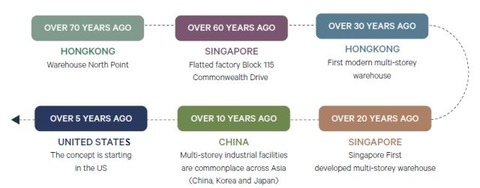|
Multi-storey facilities in high demand
Given the massive warehousing demand fueled by e-commerce, coupled with the outstanding advantages of modern good-grade infrastructure in prime localities, multi-storey facilities are forecasted to develop strongly in Viet Nam in the coming years, experts said.

A report on the development of multi-storey warehouses in the world. — Photo Courtesy CBRE
|
Multi-storey facilities have their roots in densely populated areas of Asia, in cities like Hong Kong, Singapore, Tokyo, Osaka or Shanghai, where demand is strong, but the land is constrained and expensive. It then appeared in Europe, the USA, and Australia due to its advantages.
In Viet Nam, the very first multi-storey factory was developed in Tan Thuan EPZ in HCM City in 2015. More than 900,000sq.m in 15 facilities across the country have been launched since then. In the next three years, the market is expected to welcome an addition of 10 facilities, doubling the total leasable area.
In a report by CBRE and BW Industrial Development Joint Stock Company (BW), it was found that due to land scarcity challenges and rising occupier demand, land values continuously reach new heights. Location and accessibility become increasingly vital for industrial occupiers and their supply chain cost management. The report said that multi-storey facilities with higher-density of land use are an optimal solution for tenants to better serve consumers’ growing demand for fast delivery.
E-commerce operations need larger footprints not only for storing more merchandise but also for additional technology facilitating picking, packing and reverse logistics. Following that, leasable areas have grown in size, and multi-storey warehouses are the perfect options, the report said.
“Reducing distance to customers by going multi-storey and making more efficient use of scarce land resources in urban areas goes a long way in helping to reduce environmental externalities as well. However, increasing density in an urban area also requires the support of other infrastructure such as road networks. Hence, choosing the right locations with easy highways access is critical,” said Fion Ng, chief operating officer of BW Industrial Development.
According to CBRE, as of the last quarter of 2022, Viet Nam had 513,957sq.m of leasing areas for multi-storey facilities, with 70 per cent in the southern region.
The expected supply to be added for the next five years is nearly one millon sq.m net leasing areas. Future projects mostly concentrate in provinces within one hour of driving from Ha Noi and HCM City.
Vacancies at multi-storey properties across Viet Nam currently stands at record lows, with an average rate of 20 per cent for the North and 23 per cent for the South in 2022.
Given the massive warehousing demand fueled by e-commerce, coupled with the outstanding advantages of modern good-grade infrastructure in prime localities, multi-storey facilities earn a rental premium 18-20 per cent higher than single-storey ones, CBRE informed.
Some newly-operating projects since 2019 by well-known warehouse operators achieved high occupancy rates after one or two years.
Regarding the tenant mix, multi-level factories are fit for light industries, with products mainly serving end-users rather than acting as intermediates for other sectors. Light industries are usually less capital-intensive and more consumer-oriented; hence, these tenant groups tend to locate their manufacturing bases close to urban areas with a high concentration of customer base.
In Viet Nam, food and beverage accounts for the majority of occupied space (20 per cent), followed by the plastic industry (19 per cent), printing (18 per cent) and electronics (13 per cent).
According to CBRE, due to its various advantages, switching from traditional industrial space to multi-storey ones is now at the top of the list for both developers and occupiers. Building multi-level facilities with higher floor space utilisation also helps to provide faster delivery with an effectively improved distribution network, CBRE said.
“In Viet Nam, multi-storey establishments are not poised to overtake traditional ones anytime soon, but they are getting more common in urban areas. Cities and provinces like HCM City, Dong Nai, Binh Duong, Long An, Hai Duong and Bac Ninh are currently witnessing the most building activity of multi-storey warehouses/factories. As e-commerce continues to experience an unprecedented level of growth and fast delivery is vital in today’s world of business, we believe multi-storey facilities will have to be the future of the industrial market,” said Dung Duong, executive director, CBRE Vietnam.
For occupied space, a leasable area of 1,000-5,000sq.m is most favoured, substantially smaller than that seen in single-storey facilities with inquiries ranging from 5,000-10,000sq.m.
Bizhub
|